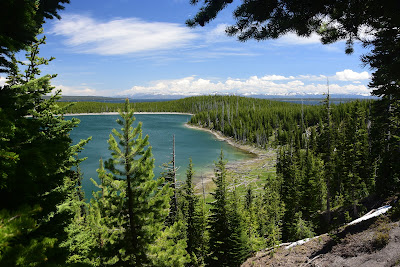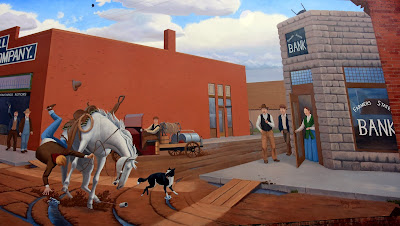A moment ago, before I settled in to write the blog, I was scrolling through Facebook in search of the country's news developments in the last 24 hours, or perhaps a message from a friend or two. But at one point the following quote appeared on my Facebook page, with a note that the quote was by one Joseph Addison (1672-1719), and that I had posted it some years back. It said: "True happiness is of a retired nature, and an enemy to pomp and noise; it arises, in the first place, from the enjoyment of one's self; and, in the next, from the friendship and conversation of a few select companions."
Mr. Addison's words rang so true in conjunction with our vacation lifestyle right now, that I thought I'd just go ahead and post them here. My reasoning is simple. As we think back on all the places we've visited, and all the adventures we've had in the last month, it's the fascinating people we have met and with whom we have spent time that has been the most memorable.Just a few minutes ago, as we were traveling east on Wyoming Route 14, and were entering the outskirts of yet another small town, I suddenly pulled over and stopped the RV on the main street of Dayton, Wyoming, population 575. I had seen a large sign for "ICE CREAM," and for some reason that just sounded perfect. Concetta said she didn't care for any and would just wait in the rig. So I got out and walked across the street to the combination General Store and soda fountain, my mind set on a soft-serve ice cream cone, much like the one on the sign out front.
As I approached the building, I saw a woman sitting on a bench in front of the store, sipping some sort of ice cream concoction through a straw. It looked so good, that I stopped and asked her what she was eating, just in case I wanted one, too. She told me it was a chocolate ice cream drink whose name I don't remember now, and didn't recognize at the time. I asked if the ice cream the store sold was good, and she said it was excellent. Then, I kidded her about how many calories we both were going to be consuming in the next few minutes, and she said it would be okay for her since she'd been hiking in the mountains all day. And just like that, we fell into an easy conversation about our respective lives, which we would later continue when Concetta came over, and I came out with my own "treat," a root-beer float.That sort of interaction with complete strangers is what I have come to expect here on the road. I find that everyone wants to tell you their story, listen to yours, and explore some common ground. Today, in addition to the young lady with the chocolate drink, we talked with a U.S. Forest ranger in the Big Horn Mountains, another Forest Service employee from Wisconsin who is volunteering for the summer, a couple of gung-ho hang glider pilots, one of whom lives in Mesquite, Nevada, during the winter, and a guy from Florida who comes up to work the summers in Wyoming at the KOA camp where we stayed last night in Greybull.
In reality, I find that there is almost no limit to what you can ask and have answered by complete strangers. Take Mary, for instance, the lady who lives in Wisconsin, but who volunteers with her husband as Forest Service employees at various parks around the west. I suspect that Mary is probably in her mid fifties. She's fit, intelligent, and seems to have the energy of two people. She told us she is a teacher, and works exclusively as a substitute back home. To hear her tell it, she is almost never unemployed because substitutes are so much in demand there.Concetta and I spent about twenty minutes with Mary where we learned at great length her theories on the subject of what's wrong with today's design for education and how it could be made better. Though at times frustrated, she has no intention of quitting because she loves her kids, Mary tells us. And Mary probably knows. She has degrees in Criminal Justice and Sociology, in addition to a degree in Education.
We had to let Mary get on with her work at that point, more because the mosquitoes were eating us alive than because she was boring us. But my point is that all we had to do was express an interest in Mary's life, and pretty soon we had all become best buddies. At first she didn't trust me to take her photo as she was afraid that it would end up on Facebook. But ten minutes into our talk, when she relaxed a bit, she didn't seem to care at all. We parted as Mary was scrounging all over her pickup to send us away with gifts for our grandkids, mementos from the Forest Service. What had started out as a mere lunch hour in the forest, turned out to be an interlude that we will not soon forget.Once we had pulled out of our lunch spot, and resumed our journey to the town of Sheridan, Wyoming, we only traveled a very few miles before we had to pull over again. Perhaps most people would have sailed right on by, and we almost did, too. But at the last moment, I swung the rig onto the very last vestige of the valley overlook pullout, then backed our way towards the action.
You see, what we had noticed, almost at the last moment, was a couple of hang gliding enthusiasts setting up their gliders on the tarmac of the overlook. At the time we pulled in, we were two of only a half dozen people there -- including the pilots -- and we had plenty of elbow room to get up close and photograph what was going on there.What was going on, turned out to be the proverbial one chance in a million of being in the right place at the right time to see two old duffers like myself stand on the edge of a thousand foot drop-off, take a couple of steps, and then launch themselves into the accommodating updraft of a very intimidating cliff face.
Incredibly, as we pulled up, the first pilot was just moments away from taking off. We had just enough time to stop the truck, get into position, ready our cameras, and start snapping photos. Although I didn't know the pilot at this point, I was later able to make his acquaintance when we drove down the mountain to the landing zone, a place he called the "LZ." He had been a helicopter pilot, presumably in Vietnam since he was my age. He told me that he just couldn't give up the thrill of flight when he left the army, and hang gliding was his way of staying in touch with the heavens.
His name was Jim Bowman, and I gave him my card so that he could contact me for photos later. I probably took at least 50 of his feat of bravery, starting when he was poised to take off, and finishing at the landing site a thousand feet below us.Jim had miraculously found a thermal and was able to stay aloft at least forty minutes, all while we on the ground craned our necks to keep him in sight. Rather than drift downward into the valley below as I had expected, Jim actually soared to heights hundreds of feet above us, then circled around and around, then dipped and rose, then dipped and rose again. It was truly magnificent and awesome.
Later, when I was standing next to Jim and he was folding up his rig for yet another trip up the mountain, he seemed so excited and grateful that I would go to the trouble of sending him a DVD of everything I shot of him today, that his gratitude just overwhelmed me. It made me feel like if I had accomplished nothing else today, making this Vietnam veteran happy would have been more than enough. His handshake was solid and warmly friendly, and as we shook hands for the first and probably only time, I told him to fly safe. I hope he does, for he single handedly reaffirmed for me what this trip is all about, and what I'm ever so grateful for!
So now here we are this afternoon, Concetta and I, sitting under a Linden tree at the Lazy R Campground in the town of Ranchester, reflecting on the day's events. Once again we didn't make Sheridan, even though it was our second attempt. It's less than twenty miles away at this point, so perhaps tomorrow we'll make it -- if the creeks don't rise, and we don't run across a dinosaur quarry, a wild west museum, or some other irresistible attraction here in the heartland of Wyoming.More important, though we didn't make our stated goal today, we took our time and gathered memories along the way, which has allowed us once again to savor our time upon this earth. And it's all thanks to, as Joseph Addison put it "...the friendship and conversation of a few select companions."
And if YOU set off on your own personal quest to find talkative forest rangers, hang gliding helicopter pilots, or some equally fascinating Americans, we wish you exciting destinations and memorable travels from the Davises, the Happy Wanderers.




























































